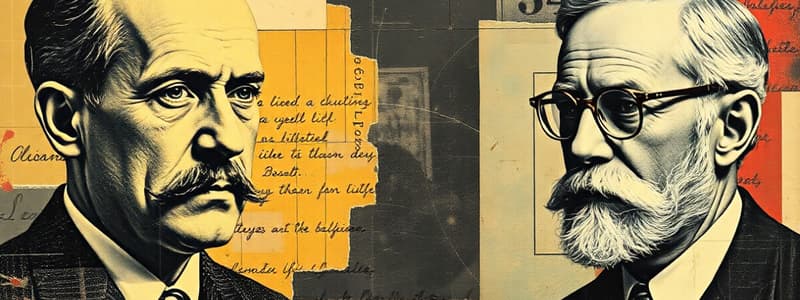Podcast
Questions and Answers
What concept did John Dalton introduce in his atomic theory?
What concept did John Dalton introduce in his atomic theory?
- Atoms are composed of both matter and energy.
- Atoms combine in simple whole-number ratios. (correct)
- Atoms of a given element are not identical.
- Atoms can be divided into smaller particles.
Which of the following best describes Ernest Rutherford's contribution to atomic theory?
Which of the following best describes Ernest Rutherford's contribution to atomic theory?
- He proposed the plum pudding model.
- He discovered the neutron.
- He formulated the uncertainty principle.
- He identified the dense nucleus of an atom. (correct)
What did Niels Bohr introduce to the atomic model?
What did Niels Bohr introduce to the atomic model?
- All elements emit light of the same spectrum.
- Atoms cannot change their energy levels.
- Electrons travel in fixed orbits. (correct)
- Electrons have both mass and charge.
The Heisenberg Uncertainty Principle states that:
The Heisenberg Uncertainty Principle states that:
What do isotopes have in common?
What do isotopes have in common?
Which of the following statements about the quantum model is true?
Which of the following statements about the quantum model is true?
Which statement accurately defines atomic number (Z)?
Which statement accurately defines atomic number (Z)?
What does the Schrödinger Equation help to describe?
What does the Schrödinger Equation help to describe?
Which model replaced the fixed orbits of electrons?
Which model replaced the fixed orbits of electrons?
Which of the following best describes the concept of ions?
Which of the following best describes the concept of ions?
Flashcards are hidden until you start studying
Study Notes
Early Theories of Atoms
- Democritus (400 BC): Proposed that matter is composed of indivisible particles called "atomos".
- Aristotle: Rejected atomic theory, favoring continuous matter model; his views dominated for centuries.
Atomic Development in the 19th Century
- John Dalton (1803): Introduced atomic theory; suggested:
- Elements are made of atoms.
- Atoms of a given element are identical.
- Atoms combine in simple whole-number ratios to form compounds.
- J.J. Thomson (1897): Discovered the electron using cathode rays; proposed the "plum pudding model" where electrons are embedded in a positively charged "soup".
Rutherford and the Nucleus
- Ernest Rutherford (1909): Conducted the gold foil experiment:
- Found that atoms have a dense, positively charged nucleus.
- Proposed that electrons orbit this nucleus, similar to planets around the sun.
Bohr Model
- Niels Bohr (1913): Improved atomic model by introducing quantized orbits for electrons:
- Electrons can only occupy certain energy levels.
- Explain the emission spectra of hydrogen.
Quantum Mechanics and the Atom
- Wave-Particle Duality: Electrons exhibit both particle and wave properties.
- Heisenberg Uncertainty Principle: It is impossible to know both the position and momentum of an electron simultaneously.
- Schrödinger Equation: Developed the wave function to describe the behavior of electrons in atoms.
Modern Atomic Theory
- Quantum Model: Electron cloud model replaces the fixed orbits; probability distributions describe where electrons are likely to be found.
- Electron Configuration: Arrangement of electrons in an atom’s orbitals determines chemical properties.
- Periodic Table: Organizes elements by atomic number and electron configuration, revealing periodic trends (e.g., reactivity, ionization energy).
Key Concepts
- Atomic Number (Z): Number of protons in the nucleus; defines the element.
- Mass Number (A): Total number of protons and neutrons in the nucleus.
- Isotopes: Atoms of the same element with different numbers of neutrons.
- Ions: Atoms that have gained or lost electrons, resulting in a charge.
Ancient Theories of Atoms
- Democritus: Matter consists of indivisible particles called "atomos".
- Aristotle: Rejected the atomic theory, proposing matter is continuous, his views dominated for centuries
Atomic Theory in the 19th Century
- Dalton's Atomic Theory: Elements consist of atoms, atoms of an element are identical, atoms combine in whole-number ratios
- Thomson: Discovered electrons using cathode rays, proposed the "plum pudding" model where electrons are embedded in a positively charged substance.
Rutherford and the Nucleus
- Gold Foil Experiment: Rutherford discovered the nucleus of an atom is dense and positively charged.
- Rutherford Model: Electrons orbit the nucleus like planets around the sun.
Bohr Model:
- Quantized Orbits: Electrons exist in specific energy levels called orbits
- Explained Hydrogen Spectra: The model explains the energy levels and the spectral lines emitted by hydrogen.
Quantum Mechanics and the Atom
- Wave-Particle Duality: Electrons possess both wave and particle properties.
- Heisenberg Uncertainty Principle: The position and momentum of an electron cannot be known simultaneously.
- Schrödinger Equation: Describes the behavior of electrons in atoms using a wave function.
Modern Atomic Theory
- Quantum Model: Replaces fixed orbits with probability distributions, electrons are likely to be found in certain locations.
- Electron Configuration: Arrangement of electrons in specific orbitals determines chemical properties.
- Periodic Table: Organizes elements by atomic number and electron configuration; shows periodic trends like reactivity.
Key Concepts
- Atomic Number (Z): Number of protons in the nucleus, defining the element
- Mass Number (A): Sum of protons and neutrons, determining the atom’s mass.
- Isotopes: Atoms of the same element with different numbers of neutrons
- Ions: Atoms that have lost or gained electrons, resulting in a charge.
Studying That Suits You
Use AI to generate personalized quizzes and flashcards to suit your learning preferences.




